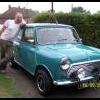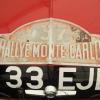
My Re Built Block Seems Stiff
#1

Posted 10 September 2012 - 11:57 AM
Cleaned the bores
Fitted new rings
Duplex timing gear
New shell bearings
New thrust washers
I have bolted it together and tightened up to the correct torque
It just seems very stiff it will turn but I have to use a long ratchet on the end of the crank and it takes a little bit of force to get it moving
This is my first engine build and I am just a bit worried and wanted to check what you guys think
Many thanks
#2

Posted 10 September 2012 - 12:02 PM
really when you rebuilt you should turn the crank after fitting each component, that way you can see if any have caused excessive friction.
ie fit the crank with big ends and thrust washer...turn the crank is it free to turn.
fit each conrod and piston in turn, after each again turn the crank.
have you squirted plenty of oil up the bores ?? were the shells well lubricated
Edited by lrostoke, 10 September 2012 - 12:02 PM.
#3

Posted 10 September 2012 - 12:14 PM
The piston rings should be removed (carefully) from the pistons and each ring placed in turn squarely in it's bore and the ring gap measured. The gap should be a minimum of 0.003" per 1" of cylinder bore diameter.
It's a good iengineering practice to do a 'dummy build' installing crank and rods/pistons, but without piston rings fitted to check correct crank rotation and to see if the block deck needs skimming and if so by how much. The piston tops should come to within 0.005" of the block deck.
After the dummy build the rods are removed, the rings (carefully) re-fitted and the pistons finally fitted. It is vital that the road caps are the correct way around.
The crank will and should be a bit stiff with new bores and pistons/rings, but not excessively so. It will not be easy to turn it by hand, especially when the pistons are all at mid-stroke and a screwdriver through the flywheel locking slot is usually required. Make sure the bores are lubricated and that the assembly was done using 'engine assembly lube' and 20w50 oil where necessary, especially inside the oil pump.
#4

Posted 10 September 2012 - 02:24 PM
Before laying the crank into the block bearing shell halves, lubricate the shells and crank journals with plenty of 20w50 oil.
Do the same with the thrust washers.
Lower the crank into the block, then lubricate the main bearing caps and lower thrust washers then nip up each main bearing cap, checking for ease of rotation of the crank.
Torque each main bearing cap up and to quote David Vizard, the crank should spin freely by turning the tail between thumb and index finger....it should take no more force than this to spin the crank freely.
Install each piston in its bore after measuring ring gaps and re-installing the rings. The crank will be more difficult to turn with all 4 pistons on mid stroke, but with the pistons at the top/bottom of their stroke, the crank should again turn freely during the "dwell" angle where the pistons are stationary in their bores!
Edited by Stevie W, 10 September 2012 - 02:24 PM.
#5

Posted 10 September 2012 - 05:18 PM
#6

Posted 10 September 2012 - 05:32 PM
Strip it and start again maybe? Or stick with it and see if it "runs in" is it just because its all new im still not sure what to do with it
Thanks for replies so far its all very helpful stuff to note
#7

Posted 10 September 2012 - 06:39 PM
Did you 'gap' the rings before fitting the pistons?
Did you check for free rotation after fitting each individual rod/piston?
Did you check the crank end float?
Answer 'no' to any of these and it would be best to strip and do it again more thoroughly.
Clearly you didn't do a 'trial build' before final assembly.
This is not a criticism as we all have to learn, but building a 'good' engine is quite a long job, which is why proper professional engine-builders are not cheap. You can do it yourself with care and have a really good engine. Just ask on here for any more advice you might need.
Edited by Cooperman, 10 September 2012 - 06:41 PM.
#8

Posted 10 September 2012 - 09:42 PM
No
Yes
No
Ill whip it apart i think
Its not attached to the box or head so not that bad
I didnt see anything in my book about "gap the rings" how do you go about it, i just popped them on and aligned them as indicated
Will i be able to re use the bearings now ive already tightened them up
Thanks for your time, nothing is taken as criticism im just glad of the help to learn how to do it better and not spoil anything on start up
Edited by Club man, 10 September 2012 - 09:42 PM.
#9

Posted 10 September 2012 - 10:07 PM
Now remove the rings from the pistons (very carefully - it's so easy to snap a piston ring). The rings MUST go back in the correct positions and the correct way up, so note these positions. Put each ring, in turn, into the bore in which it will end up. Get an old piston and push the ring down the bore about an inch so that it is sitting square in the bore. With a set of feeler gauges measure the gap in the ring. It should be a minimum of 0.003" per 1" of bore diameter, so for a Mini with about 2.5" bore a minimum gap of 0.008" is needed. If it is less than this, use a small draw-file and a piece of emory cloth the make the gap correct and smooth off any filing burrs. Let me say again, it is so very easy to snap a piston ring at which point a new set will be needed at around £50 a set.
Whilst the rings are off the pistons do a 'dummy build' and re-fit the rods/pistons with the rings off. Now make sure with each rod fitted in turn the engine turns with virtually no more stiffness than with just the crank, as the pistons without rings will not cause any drag.
Bring the pistons, in turn, to TDC and measure how far the piston top is below the block deck. Use a steel rule and feeler gauges for that. If it is 0 to 0.010" it's OK, but more than that and the block deck should be skimmed to make the pistons 0.002" to 0.005" down the bores at TDC.
There should be a small chamfer of about 0.025" around the top of each bore to help the rings slide in when fitted to the pistons.
Re-fit the rings in their original positions and re-fit the rods/pistons.
Use 'Engine Assembly Lube' on all surfaces of bearings and in the oil pump.
I hope this helps a bit.
#10

Posted 10 September 2012 - 10:34 PM
Ill let you know what happens
Thanks again
#11

Posted 11 September 2012 - 06:35 AM
#12

Posted 11 September 2012 - 09:29 AM
It is easy to simply put a big-end cap on the wrong way round and cause a very stiff engine which would not last long if left uncorrected.
The two edges with the little 'tangs' on the rod and cap should both go the same side when assembled.
On the main bearing caps the two end ones will only go on one way, but note that the cast-in ident on the centre cap should face the same way as the end ones, i.e. it can be read from thre same end of the engine.
If the end float does not start when re-built within the correct tolerances it can lead to flywheel and clutch problems as the thrust bearings wear. Please note that if you start the engine with the clutch pressed down it will increase the rate of wear on the thrust bearings due to a lack of oil flow around them until the pressure comes up.
i hope this helps.
#13

Posted 20 November 2012 - 02:46 PM
I removed the timing cover and chain ect - still stiff
I then removed the 3 main crank shaft bearings - still stiff
Then loosened the 4 piston rod bearings off and I could turn it nicely by hand
So there's my problem but why???
The rods and caps where kept together so arnt mismatched I have replaced the bearings with new std size ones from mini spares
Both The little tabs where at the same sides
The old bearings looked fine I was replacing just as part of the rebuild
Old nos = 12g 3486
New nos = vp 2783 std
Could I have tourqed them up wrong or is there somthing I'm missing
Thanks for reading
Edited by Club man, 20 November 2012 - 02:47 PM.
#14

Posted 20 November 2012 - 06:11 PM
Take the rings off the pistons anmd gap them to make sure they are OK.
Then do the trial buils as I discussed above and rotate after installing each rod & piston. That way if one is stiff it'll be immediately obvious.
Then, when it is rotating smoothly with no rings fitted to the pistons, strip it, fit the correctly gapped rings & finally assemble.
Did you check the crank end float and correct it if necessary?
#15

Posted 21 November 2012 - 05:27 PM
http://www.theminifo...gs-reformatted/
End float between 0.002" and 0.003"
Ring gaps good
Piston height good
All caps the correct way round
The crank turns nice and smooth by hand without pistons fitted
I started fitting the pistons one at a time starting with no 4 opposite end from the fan
No 4 fitted and still turned by hand ok
fitted no 3 very hard to turn so loosened off
Fitted no 2 turned fine
Fitted no 1 turned fine
Fitted no 3 again and it stiffened up again so definatly here i think
If i use a bit of force like a hit with a rubber mallet or use my long bar it will all start turning and keep turning ok but if i leave it and go back later its tight again and requires force again to get it to move but then does seem to rotate ok with minimal force considering new rings and bores can make things stiff
I feel like ive learnt alot doing this the last few weeks but its really frustrating
Any thoughts/advise, appreciated
Edited by Club man, 21 November 2012 - 05:28 PM.
1 user(s) are reading this topic
0 members, 1 guests, 0 anonymous users
















